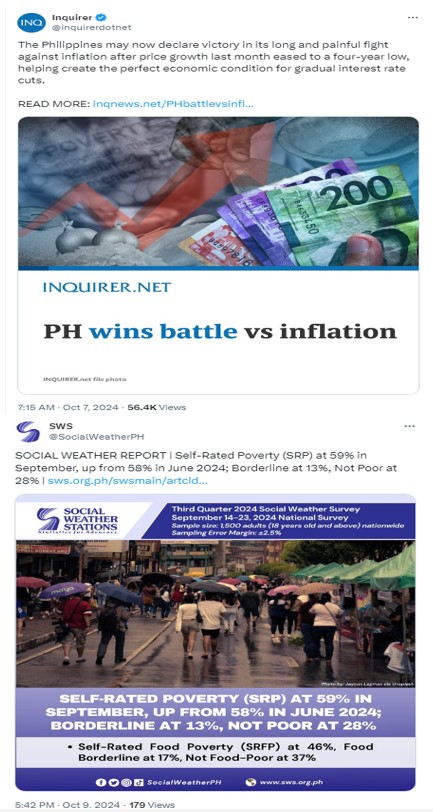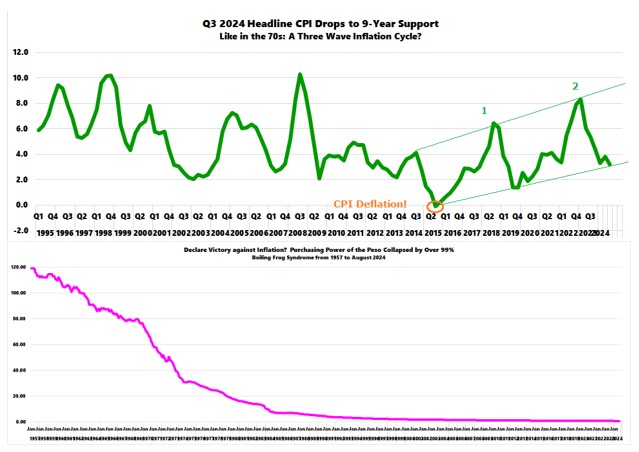Has the Philippine Government Won Its Battle Against Inflation? SWS Self-Poverty Survey Disagrees, Unveiling Its Hidden Messages
There is no escape from debt. Paying for the government’s fictitious promises in paper money will result in a constantly depreciating currency, thereby impoverishing those who earn a wage or have savings. Inflation is the hidden tax, and it is very convenient for governments because they always blame shops or businesses and present themselves as the solution by printing even more currency. Governments want more inflation to reduce the impact of the enormous debt and unfunded liabilities in real terms. They know they can’t tax you more, so they will tax you indirectly by destroying the purchasing power of the currency they issue—Daniel Lacalle
In this issue
Has the Philippine Government Won Its Battle Against Inflation? SWS Self-Poverty Survey Disagrees, Unveiling Its Hidden Messages
I. Unveiling the Likely Hidden Messages Behind the Declaration of Victory Over Inflation
II. Treasury Curve was Spot On about Inflation, Short-Term Treasury Yields Plunge! Will the BSP Cut by 50 bps?
III. Supply-Side Disinflation? Despite Strong Credit Growth, Manufacturing Remains in the Doldrums, as Reflected by PPI Deflation and Output Sluggishness
IV. Supply-Side Disinflation? Lethargic Consumer Imports and July FDI Reflect Frail Capital Goods Imports
V. Demand-Side Disinflation? September CPI Plunged Despite Vigorous August Consumer Bank Lending, Liquidity Growth Dived
VI. Disinflation with Employment at Near Historic Highs Backed by a Credit Boom? Slower Deficit Spending Puts Pressure on Liquidity Strains
VII. SWS’s Self-Rated Poverty Survey versus the Government’s CPI
Has the Philippine Government Won Its Battle Against Inflation? SWS Self-Poverty Survey Disagrees, Unveiling Its Hidden Messages
One Philippine media outlet proclaimed that the Philippine government won its battle against inflation, while a private survey contradicted this view. Who’s right?
I. Unveiling the Likely Hidden Messages Behind the Declaration of Victory Over Inflation

Figure 1
Two interesting headlines that hallmark this week’s conflicting message on inflation.
Inquirer.net, October 7, 2024: The Philippines may now declare victory in its long and painful fight against inflation after price growth last month eased to a four-year low, helping create the perfect economic condition for gradual interest rate cuts…The BSP is now at a point where it has to undo its most forceful tightening actions in two decades, which had sent the benchmark rate to its highest level in 17 years to tame stubbornly high inflation. Cutting borrowing costs is necessary amid market predictions that the economy may grow below the government’s target for this year after consumption showed signs of weakening…Moving forward, Governor Eli Remolona Jr. said the central bank would take “baby steps” until the key rate falls to 4.5 percent by the end of 2025, suggesting that monetary authorities would unlikely resort to jumbo cuts that may stir up market fears that the economy is headed for a hard landing. (bold mine)
SWS.org.ph, October 9, 2024: The national Social Weather Survey of September 14-23, 2024, found 59% of Filipino families rating themselves as Mahirap or Poor, 13% rating themselves as Borderline (by placing themselves on a line dividing Poor and Not Poor), and 28% rating themselves as Hindi Mahirap or Not Poor. The September 2024 percentage of Self-Rated Poor families rose by 1 point from 58% in June 2024, following a significant 12-point rise from 46% in March 2024. This was the highest percentage of Self-Rated Poor families since June 2008. The estimated numbers of Self-Rated Poor families were 16.3 million in September 2024 and 16.0 million in June 2024. The percentage of respondent households rating themselves as poor was applied to the Philippine Statistics Authority medium-population projections for 2024 to arrive at the estimated numbers of Self-Rated Poor families… The September 2024 survey found the percentage of Borderline families at 13%, up by 1 point from the record low 12% in June 2024 following an 18-point decline from 30% in March 2024… As of September 2024, the percentage of Not Poor families was at 28%, 2 points below the record high 30% in June 2024. (bold mine)
First and foremost, what does “declare victory in its long and painful fight against inflation” mean? (Figure 1, upper tweet)
The Philippine CPI posted two straight months of DEFLATION (statistical price decreases) in September (-0.37%) and October (-0.19%) 2015; yet, the media and establishment experts barely made such a brazen pronouncement until now.
Yes, Q3 2024 statistical inflation of 3.2% has dropped to its 9-year support level, but this doesn’t mean that the inflation cycle has been broken.

Figure 2
In Q3 2015, the CPI slipped into deflation at -0.1%, which prompted banks to accelerate their net claims on central government (NCoCG) or indirect QE. Ironically, this germinated the current inflation cycle, which is now on its ninth-year. (Figure 2 upper image)
Despite its recent decline, given that the CPI has remained on an uptrend since 2015 and appears to have settled at the support levels, what assurances does the establishment hold that it won’t be subject to a third wave?
Second, the September CPI of 1.9% doesn’t translate to the evisceration of inflation; it only means that GENERAL prices have risen at REDUCED rates (or have dropped to within the BSP’s target), but they are still RISING!
In fact, BSP data tell us that even in the context of the understated inflation rate, over 99% of the purchasing power of the peso has been eroded since 1957! How is that for “declaring victory over inflation”? (Figure 2, lower chart)
On the other hand, while authorities and media bask in this pretentious statistical feat, a private sector survey tell us a different story: slower inflation has exposed the persistent and growing burden of a lower standard of living! (More on this below.) (Figure 1, lower tweet)
Third, “declaring victory over inflation” was NEVER a goal of the BSP’s monetary policy anchored on inflation targeting.
From the BSP: The primary objective of the BSP’s monetary policy is “to promote price stability conducive to a balanced and sustainable growth of the economy” (Republic Act 7653). The adoption of inflation targeting framework of monetary policy in January 2002 is aimed at achieving this objective. Inflation targeting is focused mainly on achieving a low and stable inflation, supportive of the economy’s growth objective. This approach entails the announcement of an explicit inflation target that the BSP promises to achieve over a given time period. (bold mine)
There is no defined quantification or qualification of “low and stable inflation” because statistical inflation has always been a subjective measure, arbitrarily defined by the BSP.
That said, the goal of the politics behind inflation targeting has been to keep the inflation “genie” confined within the boundaries of the BSP’s proverbial “lamp.”
That’s because inflation, as a hidden tax, benefits the government most.
However, the inflation genie has been set loose, or has gone beyond its bounds, marking the difference between the previous era and today.
In this way, the BSP can be conservatively said to have been “asleep at the wheel.”
At worst, and unbeknownst to the public, the BSP’s policies have unleashed the inflation genie!
Or, although authorities continue to push the narrative of supply-side-driven inflation to shift the blame onto the private sector, the current inflation cycle signify an unintended consequence of their policies!
Yet, has anyone among the array of establishment experts, including those in government, been correct in predicting the incumbent inflation cycle?
Fourth, the CPI is just a statistic. While its intent is to approximate changes in general prices, it neither reveals the full accuracy nor explains the causes of those changes.
The fact is that inflation statistics are misleading.
My inflation rate and yours are different. This is because of dynamic individual spending habits and ever-changing preferences that vary not only over time but also differs across individuals.
Is it not the averaging a Netflix subscription and rice an exercise of apples-to-oranges comparison? If so, would this not be applied to the CPI?
Or, not only is the weighted averaging of goods and services across different groups of people a flawed metric, but people’s spending preferences are constantly changing!
How accurate is an inflation rate derived from averaging the spending patterns of billionaires with those of the bottom 30%?
Even on a personal level, my preferences are always changing. If I prefer sautéed prawns with bread this moment, adobo with rice later, and only sinigang for tomorrow, how could the inputs used to create these meals be accurately averaged? How would this apply to a population of 110 million people?
Furthermore, because the CPI is a politically sensitive statistic—created and calculated by politically sensitive institutions—it is prone not only to errors (in assumptions, inputs, etc.) but also to political biases.
For instance, changing the base year of the CPI can lead to different outcomes. If I’m not mistaken, using the now-defunct 2006 base would produce a much higher CPI today than the current 2018 base.
Since the CPI is used as a primary benchmark for the market’s pricing of interest rates, wouldn’t the government—as the biggest borrowers—have the incentive or motivation to suppress it to influence the cost of borrowing?
Fifth, what happened to journalism?
Isn’t journalism about “seeking truth and providing a fair and comprehensive account of events and issues“?
When media outlets use ambiguous qualifications like ” declare victory against inflation” to describe the “perfect economic condition for gradual interest rate cuts” intended to support “consumption (which) showed signs of weakening,” could this not signify cheerleading or an advocacy for a biased policy stance? For whose benefit?
Might this be seen as advancing the interests of vested groups, particularly the primary beneficiary, the government and the politically connected elites? How is this different from propaganda, misinformation, or disinformation?
Importantly, if an alleged news article makes an economic generalization, why would it lack narratives supported by economic logic?
Or, are low rates a GUARANTEE of an INCREASE in consumption? How so, and based on what theory and evidence?
Why cite partisan and non-sequitur explanations from “establishment experts” whose principal-agent problems have hardly been laid bare to the public?
Have media outlets distilled such insights or selected statements for print that only promote their biases? I’ve seen this happen (personally) before, which is why I refuse interviews.
Sixth, if media pronouncements reflect exuded marketplace confidence, could such article/s signify a manifestation of the magazine/headline cover indicator or express an extreme state of sentiment?
Or have the media’s declarations echoed the “overconfidence” stemming from recent euphoria over the price spikes in Philippine assets (stocks, bonds, and the peso)?
Seventh and lastly, could this be related to the upcoming elections?
Will declaring ‘victory in its long and painful fight against inflation’ be part of the campaign to promote the electoral chances of the administration’s national slate in the 2025 midterm elections?
Ultimately, the establishment’s obsession has been to promote a regime of easy money, using the declaration of triumph over inflation as justification.
As the great Austrian economist Ludwig von Mises once explained
The popularity of inflation and credit expansion, the ultimate source of the repeated attempts to render people prosperous by credit expansion, and thus the cause of the cyclical fluctuations of business, manifests itself clearly in the customary terminology. The boom is called good business, prosperity, and upswing. Its unavoidable aftermath, the readjustment of conditions to the real data of the market, is called crisis, slump, bad business, depression. People rebel against the insight that the disturbing element is to be seen in the malinvestment and the overconsumption of the boom period and that such an artificially induced boom is doomed. They are looking for the philosophers’ stone to make it last (Mises, 2019)
_____
Please read the rest here:
blogspot or
https://prudentinvestornewsletters.blogspot.com/2024/10/has-philippine-government-won-its.html
substack
https://open.substack.com/pub/theseenandunseenbybjte/p/has-the-philippine-government-won?
Anyone can join.
Anyone can contribute.
Anyone can become informed about their world.
"United We Stand" Click Here To Create Your Personal Citizen Journalist Account Today, Be Sure To Invite Your Friends.
Before It’s News® is a community of individuals who report on what’s going on around them, from all around the world. Anyone can join. Anyone can contribute. Anyone can become informed about their world. "United We Stand" Click Here To Create Your Personal Citizen Journalist Account Today, Be Sure To Invite Your Friends.
LION'S MANE PRODUCT
Try Our Lion’s Mane WHOLE MIND Nootropic Blend 60 Capsules
Mushrooms are having a moment. One fabulous fungus in particular, lion’s mane, may help improve memory, depression and anxiety symptoms. They are also an excellent source of nutrients that show promise as a therapy for dementia, and other neurodegenerative diseases. If you’re living with anxiety or depression, you may be curious about all the therapy options out there — including the natural ones.Our Lion’s Mane WHOLE MIND Nootropic Blend has been formulated to utilize the potency of Lion’s mane but also include the benefits of four other Highly Beneficial Mushrooms. Synergistically, they work together to Build your health through improving cognitive function and immunity regardless of your age. Our Nootropic not only improves your Cognitive Function and Activates your Immune System, but it benefits growth of Essential Gut Flora, further enhancing your Vitality.
Our Formula includes: Lion’s Mane Mushrooms which Increase Brain Power through nerve growth, lessen anxiety, reduce depression, and improve concentration. Its an excellent adaptogen, promotes sleep and improves immunity. Shiitake Mushrooms which Fight cancer cells and infectious disease, boost the immune system, promotes brain function, and serves as a source of B vitamins. Maitake Mushrooms which regulate blood sugar levels of diabetics, reduce hypertension and boosts the immune system. Reishi Mushrooms which Fight inflammation, liver disease, fatigue, tumor growth and cancer. They Improve skin disorders and soothes digestive problems, stomach ulcers and leaky gut syndrome. Chaga Mushrooms which have anti-aging effects, boost immune function, improve stamina and athletic performance, even act as a natural aphrodisiac, fighting diabetes and improving liver function. Try Our Lion’s Mane WHOLE MIND Nootropic Blend 60 Capsules Today. Be 100% Satisfied or Receive a Full Money Back Guarantee. Order Yours Today by Following This Link.






